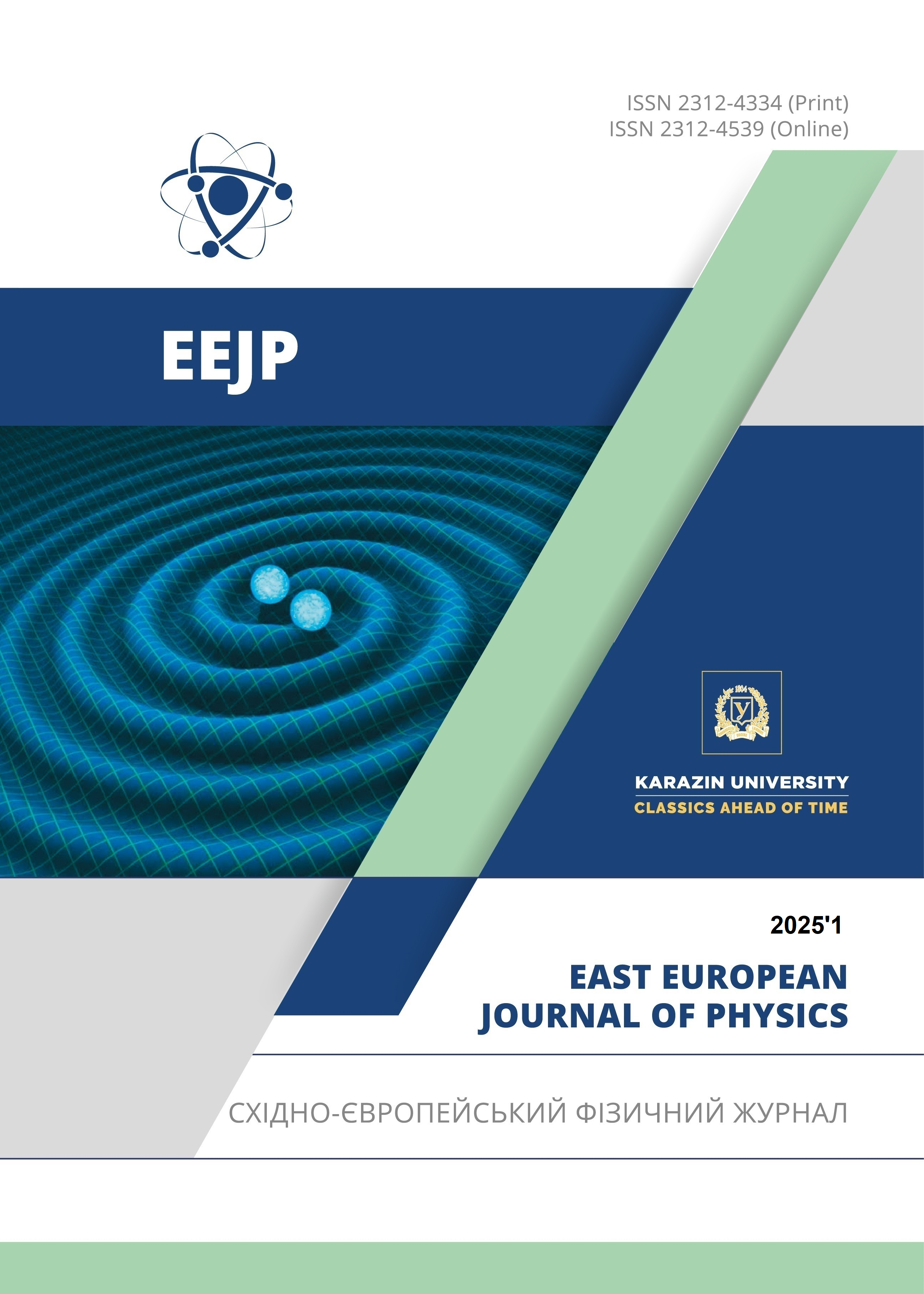Оптимізація органічних фотодетекторів за допомогою моделювання SCAPS-1D: підвищення продуктивності пристроїв на основі PBDB-T-2F шляхом конфігурації шару та регулювання легування
Анотація
У цьому дослідженні ми провели дослідження оптимізації різних параметрів фотодетектора за допомогою моделювання SCAPS-1D для підвищення його загальної продуктивності. Конструкцію фотоприймача модифіковано на основі структури, запропонованої Н.І.М. Ібрагім та ін. (AMPC, 14(04), 55–65 (2024) шляхом зміни порядку шару транспортування дірок (HTL) та шару транспортування електронів (ETL). Завдяки оптимізації товщини шару та концентрації легування ми значно покращили фотоелектричні параметри нашої оптимізованої структури (FTO/PFN/PBDB-T-2F/PEDOT/Ag). 1,02 В, JSC 35,20 мА/см², FF 84,61 % і загальний ККД 30,40 % Крім того, пристрій продемонстрував високу квантову ефективність (EQ) понад 99 % і чутливість із піком 0,65 А/Вт, охоплюючи широка спектральна область від 300 нм до 900 нм результати вказують на критичну роль ретельної оптимізації при розробці високоефективних фотодетекторів, надаючи цінну інформацію про проектування та виготовлення пристроїв із чудовими характеристиками продуктивності.
Завантаження
Посилання
G. Luo, et al., “Boosting the Performance of Organic Photodetectors with a Solution-Processed Integration Circuit toward Ubiquitous Health Monitoring,” Advanced Materials, 35(36), 2301020 (2023). https://doi.org/10.1002/adma.202301020
N.S. Hamzah, and E.K. Hassan, “Fabrication and Enhancement of Organic Photodetectors Based on Iron Phthalocyanine Films, International Journal of Nanoscience, (2024). https://doi.org/10.1142/S0219581X2350028X
J.-W. Qiao, F.-Z. Cui, L. Feng, P. Lu, H. Yin, and X.-T. Hao, “Efficient Ultrathin Self-Powered Organic Photodetector with Reduced Exciton Binding Energy and Auxiliary Föster Resonance Energy Transfer Processes,” Advanced Functional Materials, 33(30), 2301433 (2023). https://doi.org/10.1002/adfm.202301433
W. Liu, Q. Liu, J. Xiao, Y. Wang, L. Yuan, H. Tai, and Y. Jiang, “Performance enhancement of an organic photodetector enabled by NPB modified hole transport layer," IOPscience, 55, 234001 (2024). https://doi.org/10.1088/1361-6463/ac5990
P. Jacoutot, et al., “Enhanced sub-1 eV detection in organic photodetectors through tuning polymer energetics and microstructure,” Science Advances, 9(23), eadh2694 (2023). https://doi.org/10.1126/sciadv.adh2694
X. Yan, X. Wang, S. Gao, and W. Qiao, “High-Performance Organic Photodetectors Using SnO2 as Interfacial Layer with Optimal Thickness,” Physica Status Solidi (a), 220(1), 2200667 (2023). https://doi.org/10.1002/pssa.202200667
P. Corral, F. Rodriguez-Mas, G.D. Scals, D. Valiente, J.C. Ferrer, and S.F. de Avila, “Improvements of Organic Photodetectors for VLC Using a New Active Layer, Focal Lens, and a Transimpedance Amplifier,” Elektronika ir Elektrotechnika, 28(4), 4 (2022). https://doi.org/10.5755/j02.eie.31292
J. Kang, et al., “Enhanced Static and Dynamic Properties of Highly Miscible Fullerene-Free Green-Selective Organic Photodetectors,” ACS Appl. Mater. Interfaces, 13(21), 25164–25174 (2021). https://doi.org/10.1021/acsami.1c02357
J. Wang, et al., “Enhanced photomultiplication of organic photodetectors via phosphorescent material incorporation,” J. Mater. Chem. C, 9(47), 16918–16924 (2021). https://doi.org/10.1039/D1TC04524E
G. Manzoor, K.K. Sharma, G.K. Bharti, and D. Nath, “Modelling and Performance Analysis of CuPc and C60 Based Bilayer Organic Photodetector,” IJEER, 10(4), 811–816 (2022). https://doi.org/10.37391/ijeer.100408
W. Teng, W. Yanbin, J. Chen, and B. Wang, Active layer used for ternary blending solar cell and application of active layer, (2018). [Online Video]. https://typeset.io/papers/active-layer-used-for-ternary-blending-solar-cell-and-2rxfqsnc5q
B.-K. Choo, S. Ahn, B.-Ho Cheong, J.-w. Cho, H.-J. Cho, and H.S. Yeon, Active layer of thin film transistor crystallizing apparatus and the crystallizing method using the same, (2015). [Online Video]. https://typeset.io/papers/active-layer-of-thin-film-transistor-crystallizing-apparatus-j6u2d4hdjw
J. Tard, J. Pauchet, R. Vincent, Formulation of an active layer having improved performances, (2013). [Online Video]. https://typeset.io/papers/formulation-of-an-active-layer-having-improved-performances-39t79hc0se
Y. Zheng, Y. Cheng, L. Li, Active bio piezoelectric ceramic coating layer and method of preparing said coating layer on titanium base body surface, (2006). [Online Video]. https://typeset.io/papers/active-bio-piezoelectric-ceramic-coating-layer-and-method-of-3oleypt5z1
R.-K. Shiu, et al., “Performance Enhancement of Optical Comb Based Microwave Photonic Filter by Machine Learning Technique,” Journal of Lightwave Technology, 38(19), 5302–5310 (2020). https://doi.org/10.1109/JLT.2020.2989210
Y. Wang, et al., “Organic photovoltaics with 300 nm thick ternary active layers exhibiting 15.6% efficiency,” J. Mater. Chem. C, 9(31), 9892–9898 (2021). https://doi.org/10.1039/D1TC02748D
L. Zhan, et al., “Layer-by-Layer Processed Ternary Organic Photovoltaics with Efficiency over 18%,” Advanced Materials, 33(12), 2007231 (2021). https://doi.org/10.1002/adma.202007231
J. Gao, et al., “Over 16.7% efficiency of ternary organic photovoltaics by employing extra PC71BM as morphology regulator,” Sci. China Chem. 63(1), 83–91 (2020). https://doi.org/10.1007/s11426-019-9634-5
T. Kong, et al., “A Newly Crosslinked-double Network PEDOT:PSS@PEGDMA toward Highly-Efficient and Stable Tin-Lead Perovskite Solar Cells,” Small, 19(40), 2303159 (2023). https://doi.org/10.1002/smll.202303159
L. Jin, J. W. Zhang, and S. Ju, “Preparation and Properties of PEDOT:PSS-Based Thermoelectric Thin Films,” Materials Science Forum, 1070, 173–181 (2022). https://doi.org/10.4028/p-pmw1c6
Y. Zhou, et al., “Effects of PEDOT:PSS:GO composite hole transport layer on the luminescence of perovskite light-emitting diodes,” RSC Adv. 10(44), 26381–26387 (2020,). https://doi.org/10.1039/D0RA04425C
L. Liu, H. Yang, Z. Zhang, Y. Wang, J. Piao, Y. Dai, and B. Cai, “Photopatternable and Highly Conductive PEDOT:PSS Electrodes for Flexible Perovskite Light-Emitting Diodes,” ACS Appl. Mater. Interfaces, 15(17), 21344–21353 (2023). https://doi.org/10.1021/acsami.3c03108
H. Fu, et al., “High-performance Ag nanowires/PEDOT:PSS composite electrodes for PVDF-HFP piezoelectric nanogenerators,” J. Mater. Sci: Mater. Electron. 32(16), 21178–21187 (2021). https://doi.org/10.1007/s10854-021-06616-9
A. Pisciotta, et al., “PEDOT: PSS promotes neurogenic commitment of neural crest-derived stem cells,” Front. Physiol. 13, (2022). https://doi.org/10.3389/fphys.2022.930804
S.A. Moiz, M.S. Alzahrani, and A.N.M. Alahmadi, “Electron Transport Layer Optimization for Efficient PTB7:PC70BM Bulk-Heterojunction Solar Cells,” Polymers, 14(17), 3610 (2022). https://doi.org/10.3390/polym14173610
A. Ait Abdelkadir, and M. Sahal, “Theoretical development of the CZTS thin-film solar cell by SCAPS-1D software based on experimental work,” Materials Science and Engineering: B, 296, 116710 (2023). https://doi.org/10.1016/j.mseb.2023.116710
S. Chowdhury, A.S. Najm, M. Luengchavanon, A.M. Holi, C.H. Chia, K. Techato, and S. Channumsin, “Investigating the Effect of Nonideal Conditions on the Performance of a Planar Sb2Se3-Based Solar Cell through SCAPS-1D Simulation,” Energy & Fuels, 37(9), 6722 6732 (2024). https://doi.org/10.1021/acs.energyfuels.2c03593
M. Abdelfatah, A.M. El Sayed, W. Ismail, S. Ulrich, V. Sittinger, and A. El-Shaer, “SCAPS simulation of novel inorganic ZrS2/CuO heterojunction solar cells” Scientific Reports, 13, 4553 (2024). https://www.nature.com/articles/s41598-023-31553-4
Y. Hairch, Aelmelouky, M. Monkade, and R. Elmoznine, “Investigation of optical and electrical properties of CIGS solar cell using simulation program SCAPS and Impedance spectroscopy,” (2023). https://doi.org/10.22541/au.167872056.62172198/v1
Sk.T. Ahamed, A. Basak, and A. Mondal, “Device modeling and investigation of Sb-based low-cost heterojunction solar cells using SCAPS-1D,” Results in Optics, 10, 100364 (2023). https://doi.org/10.1016/j.rio.2023.100364
M. Muzammil, K.N. Naam, M. Fareed, M.S. Hussain, and M. Zulfiqar, “Boosting the performance of PBDB-T/ITIC based organic solar cell: A theoretical analysis utilizing SCAPS-1D,” Chemical Physics Impact, 8, 100407 (2024). https://doi.org/10.1016/j.chphi.2023.100407
G.A. Nowsherwan, et al., “Performance Analysis and Optimization of a PBDB-T:ITIC Based Organic Solar Cell Using Graphene Oxide as the Hole Transport Layer,” Nanomaterials, 12(10), (2022,). https://doi.org/10.3390/nano12101767
N.I.M. Ibrahim, A.M. Elharbi, and A. Albadri, “Study the Effect of Thickness on the Performance of PM6:Y6 Organic Solar Using SCAPS Simulation,” AMPC, 14(04), 55–65 (2024). https://doi.org/10.4236/ampc.2024.144005
S. Rafique, S.M. Abdullah, M.M. Shahid, M.O. Ansari, and K. Sulaiman, “Significantly improved photovoltaic performance in polymer bulk heterojunction solar cells with graphene oxide /PEDOT:PSS double decked hole transport layer,” Sci Rep, 7(1), 39555 (2017). https://doi.org/10.1038/srep39555
S. Rafique, et al., “UV- ozone treated graphene oxide/ PEDOT:PSS bilayer as a novel hole transport layer in highly efficient and stable organic solar cells,” Organic Electronics, 66, 32–42 (2019). https://doi.org/10.1016/j.orgel.2018.12.005
K. Tan, P. Lin, G. Wang, Y. Liu, Z. Xu, and Y. Lin, “Controllable design of solid-state perovskite solar cells by SCAPS device simulation,” Solid-State Electronics, 126, 75–80 (2016). https://doi.org/10.1016/j.sse.2016.09.012
L. Lu, and L. Yu, “Understanding Low Bandgap Polymer PTB7 and Optimizing Polymer Solar Cells Based on It,” Advanced Materials, 26(26), 4413–4430 (2014). https://doi.org/10.1002/adma.201400384
H. Lian, J. Ning, A. Bolag, A. Hexig, N. Gerile, O. Tegus, and S. Lin, “Optimization of PEDOT:PSS Hole Transport Layer Toward the Organic Solar Cells with High Fill Factor,” Scientific. Net. 113 118 (2024). https://www.scientific.net/SSP.288.113
K.S. Nithya, and K.S. Sudheer, “Numerical modelling of non-fullerene organic solar cell with high dielectric constant ITIC-OE acceptor,” J. Phys. Commun. 4(2), 025012 (2020). https://doi.org/10.1088/2399-6528/ab772a
W. Abdelaziz, A. Shaker, M. Abouelatta, and A. Zekry, “Possible efficiency boosting of non-fullerene acceptor solar cell using device simulation,” Optical Materials, 91, 239–245 (2019). https://doi.org/10.1016/j.optmat.2019.03.023
K.S. Nithya, and K.S. Sudheer, “Device modelling of non-fullerene organic solar cell with inorganic CuI hole transport layer using SCAPS 1-D,” Optik, 217, 164790 (2020). https://doi.org/10.1016/j.ijleo.2020.164790
T.N.L. Phan, J. Kim, G.-U. Kim, S. Lee, and B.J. Kim, “Aniline-based hole transporting materials for high-performance organic solar cells with enhanced ambient stability,” Journal of Materials Chemistry A, (RSC Publishing). (2024). https://pubs.rsc.org/en/content/articlelanding/2021/xx/d1ta03665c/unauth
Авторське право (c) 2025 Ахмет Саїт Алалі, Мурат Одункуоглу, Хмуд Аль-Дмур, Абделааль С.А. Ахмед

Цю роботу ліцензовано за Міжнародня ліцензія Creative Commons Attribution 4.0.
Автори, які публікуються у цьому журналі, погоджуються з наступними умовами:
- Автори залишають за собою право на авторство своєї роботи та передають журналу право першої публікації цієї роботи на умовах ліцензії Creative Commons Attribution License, котра дозволяє іншим особам вільно розповсюджувати опубліковану роботу з обов'язковим посиланням на авторів оригінальної роботи та першу публікацію роботи у цьому журналі.
- Автори мають право укладати самостійні додаткові угоди щодо неексклюзивного розповсюдження роботи у тому вигляді, в якому вона була опублікована цим журналом (наприклад, розміщувати роботу в електронному сховищі установи або публікувати у складі монографії), за умови збереження посилання на першу публікацію роботи у цьому журналі.
- Політика журналу дозволяє і заохочує розміщення авторами в мережі Інтернет (наприклад, у сховищах установ або на особистих веб-сайтах) рукопису роботи, як до подання цього рукопису до редакції, так і під час його редакційного опрацювання, оскільки це сприяє виникненню продуктивної наукової дискусії та позитивно позначається на оперативності та динаміці цитування опублікованої роботи (див. The Effect of Open Access).








